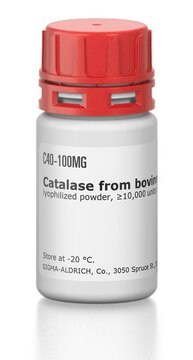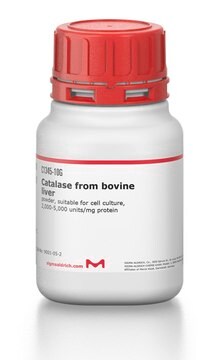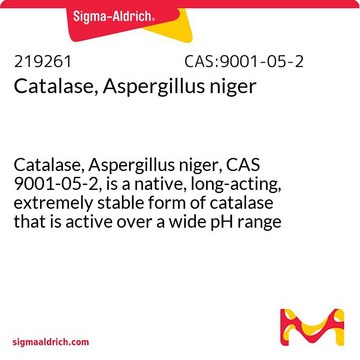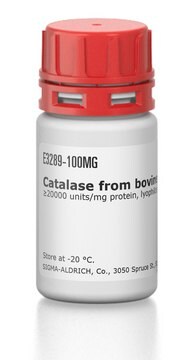C3515
Catalase from Aspergillus niger
ammonium sulfate suspension, ≥4,000 units/mg protein
Sinónimos:
H2O2:H2O2 oxidoreductase
About This Item
Productos recomendados
origen biológico
Aspergillus niger
formulario
ammonium sulfate suspension
actividad específica
≥4,000 units/mg protein
mol peso
tetramer ~250 kDa
condiciones de almacenamiento
(Tightly closed)
técnicas
FISH: suitable
Condiciones de envío
wet ice
temp. de almacenamiento
2-8°C
InChI
1S/C9H10O3/c1-2-12-9(11)7-3-5-8(10)6-4-7/h3-6,10H,2H2,1H3
Clave InChI
NUVBSKCKDOMJSU-UHFFFAOYSA-N
Descripción general
Catalase is an active enzyme present in aerobic organisms. It is a ferric hemoprotein and a tetramer.
Aplicación
- as a positive control during the functional characterization of Clostridium difficile spore coat proteins.
- as a component of the catalase solution to prepare GLOX buffer with enzymes to maintain the embryos of Caenorhabditis elegans before single-molecule fluorescence in situ hybridization (smFISH) studies
- as a component of the imaging buffer for stochastic optical reconstruction microscopy (STORM) imaging of platelet-rich plasma
- as a supplement in Todd Hewitt media plus 0.5 % yeast extract (THY) media for the neutralization of pneumococcal H2O2
Acciones bioquímicas o fisiológicas
Precaución
Definición de unidad
Forma física
Nota de análisis
Código de clase de almacenamiento
12 - Non Combustible Liquids
Clase de riesgo para el agua (WGK)
WGK 1
Punto de inflamabilidad (°F)
Not applicable
Punto de inflamabilidad (°C)
Not applicable
Certificados de análisis (COA)
Busque Certificados de análisis (COA) introduciendo el número de lote del producto. Los números de lote se encuentran en la etiqueta del producto después de las palabras «Lot» o «Batch»
¿Ya tiene este producto?
Encuentre la documentación para los productos que ha comprado recientemente en la Biblioteca de documentos.
Los clientes también vieron
Artículos
Instructions for working with enzymes supplied as ammonium sulfate suspensions
Protocolos
This procedure may be used for all Catalase products.
Nuestro equipo de científicos tiene experiencia en todas las áreas de investigación: Ciencias de la vida, Ciencia de los materiales, Síntesis química, Cromatografía, Analítica y muchas otras.
Póngase en contacto con el Servicio técnico













